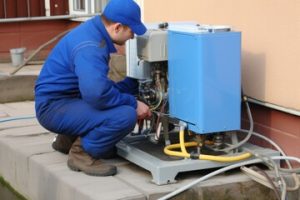Worcester Tree Removal is a difficult task that requires time and physical labor. It can also be dangerous if the stump is near a home, car or power lines.

A professional can help determine whether pruning or removal is the best option. Sometimes damage to trees makes removal the only way to keep them safe.
Stump grinding is a crucial component of tree removal and is an excellent choice when you want to get rid of unsightly, old stumps. A stump grinder uses a high-powered rotating disk, outfitted with sharp teeth, to grind away at the stump and its roots. Once the stump is reduced to wood chips, they can be removed from your property or repurposed as mulch for a garden or lawn. This technique is less invasive than excavation and takes less time to complete. It is also an environmentally friendly option as it doesn’t require destroying or disrupting existing soil.
The first step in stump grinding is to assess the area and remove any obstructions that could interfere with the process. This ensures that the work area is safe for the operator and prevents damage to any surrounding structures. It also helps the operator plan the best strategy for getting rid of the stump by understanding its size, depth, and proximity to any nearby objects.
Once the work area is cleared, the operator will position the stump grinder over the stump. The disk is lowered down over the surface, and the machine is maneuvered in a systematically way to grind the stump and its roots into wood chips. This process is typically completed in just a few hours and leaves the site ready for new planting or lawn care.
Depending on the model of stump grinder, it may be possible to dig down into the ground and completely eliminate the root system beneath. However, this can be challenging for homeowners and is best left to professionals who have the proper equipment.
Before beginning the stump grinding process, it is important to wear protective gear. This includes gloves, a face shield or goggles, and ear protection to protect yourself from debris, dust, and loud noises. You should also call 811 to identify any buried utility lines before starting work in your yard. This step is necessary to avoid damaging underground lines or causing an accident. Once the stump is ground, it is important to keep it clear of any regrowth or debris so that it does not become a tripping hazard. It is also recommended to have your stumps inspected annually to make sure that the roots are not attempting to re-establish themselves in the ground.
Epsom Salt Method
Epsom salt is an inexpensive and environmentally friendly alternative to more costly and physically demanding methods of removing a tree stump. The chemical consists of magnesium sulfate and has many other uses, including soothing sore muscles and improving plant growth. It is also effective at accelerating decomposition of the remaining stump, making it easier to remove with an ax or shovel.
Named after a town in England, Epsom salt is a natural mineral compound of magnesium and sulfate. It has long been used as a home remedy and is now a popular eco-friendly choice for eliminating unwanted tree stumps. This method is a good option for those who do not have the budget for more expensive alternatives, such as renting a stump grinder or digging the stump out by hand.
Unlike commercial products that contain potassium nitrate, the Epsom salt method works by drawing moisture from the stump, thus drying it out and allowing it to decay naturally. The process can take several months, but consistent application and patience will ensure success. Smaller, softer stumps will decay more quickly than larger and harder ones. A tarp should be placed over the stump to keep rain from washing away the salt and to prevent damage to surrounding grass and plants.
Although the Epsom salt method is relatively cheap, it can potentially taint soil quality around the stump. Therefore, it is important to avoid overuse and to use the least amount possible to minimize environmental impact.
Another benefit of using Epsom salt to kill a stump is its ability to reduce transplant shock in trees, shrubs and other hardy vegetation. This occurs when a tree or shrub is moved from one location to another and its roots become dehydrated, causing it to wilt. Adding a teaspoon of Epsom salt to the hole where the plant is planted can help it recover from this shock and thrive once again.
If you are interested in incorporating the Epsom Salt Method into your landscape, contact our tree service Dunlap IL today. Our experts can provide you with more information and guidance on this effective and easy-to-use natural solution for removing pesky tree stumps.
Burying
Wood burial is a low-cost method of carbon removal. It utilizes waste materials from forest and sawmills that would otherwise be burned or decomposed, emitting CO2 into the atmosphere. Scientists have found that burying this debris in deep soil preserves it for centuries and prevents CO2 from returning to the atmosphere. The researchers estimate that this technique could remove between 770 and 937 gigatonnes of CO2 from the atmosphere over the next 76 years, enough to cool global temperatures by up to 0.42 degrees Celsius.
This method provides many benefits to the environment and to landowners. It reduces fire risks on the land, increases the reforestation potential of the site, and generates carbon credits that can be sold in voluntary carbon markets. Mast is working with a landowner outside Billings, Montana to bury and recycle unusable dead biomass from the 2021 Poverty Flats wildfire, generating carbon credit revenue that will directly fund reforestation of the site over time.
Stumps and other wood debris can accumulate a lot of dirt at their base, especially during construction and landscaping. This dirt can suffocate the roots, damage tree cells, and prevent the root crown from receiving enough moisture to function properly. This can also lead to insect and disease infestations.
Chemical Stump Remover
Whether you opt for the magical decay induced by chemical stump removers or the gratifying toil of natural and manual removal methods, the process to a stump-free garden is one that requires careful planning. The right choice of method aligns with your environmental ethos, physical capabilities, and patience level. The process also depends on the conditions of the soil and surrounding environment. For this reason, preparing the ground for successful stump removal is an essential part of the overall process. This includes aerating the soil, enriching it with nutrients, and maintaining adequate moisture levels. By implementing these preparatory steps, you’ll lay the foundation for the effective application of tree stump removers.
The first step in the chemical stump removal process involves drilling holes into the surface of the stump. These holes should be evenly spaced and deep enough to reach the roots. After this, the stump remover solution is poured into the holes. The holes should be covered with a tarp or plastic sheet to prevent the solution from spilling out of the holes. The stump must be covered for several weeks to allow the chemicals to penetrate into the stump and begin decomposition.
There are a number of different types of stump removal solutions available, including potassium nitrate, Epsom salt, and vinegar. Each has its own benefits and drawbacks. However, potassium nitrate is typically the most popular and widely used. This is due to its ability to accelerate the decomposition of a stump, making it easier to remove.
When using a chemical stump remover, it is important to use caution and adhere to all instructions and safety precautions. This is especially true if there are children or pets around the site. Wearing protective gear such as gloves, goggles, and a mask is vital to protect against possible splashes or inhalation of chemicals. It is also a good idea to test the soil for contaminants before beginning the stump removal process. This will ensure that the chemicals won’t contaminate surrounding plants or water sources.
While DIY stump removal can be possible for certain stumps, it is often recommended to hire a professional. This way, you can be sure that the process will be completed quickly and correctly. A professional will have the proper equipment and knowledge to remove even the most stubborn of stumps without causing damage or injury.


